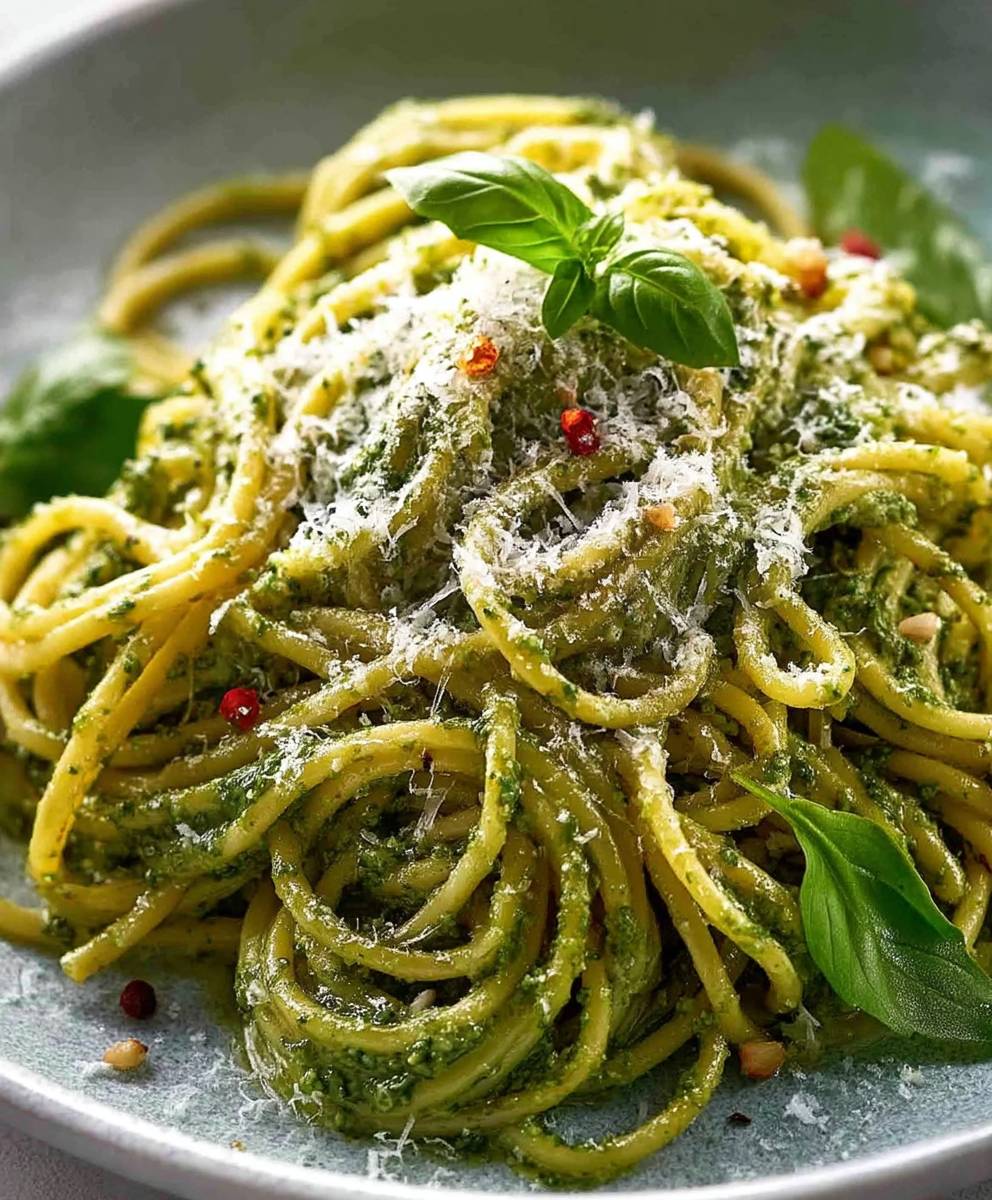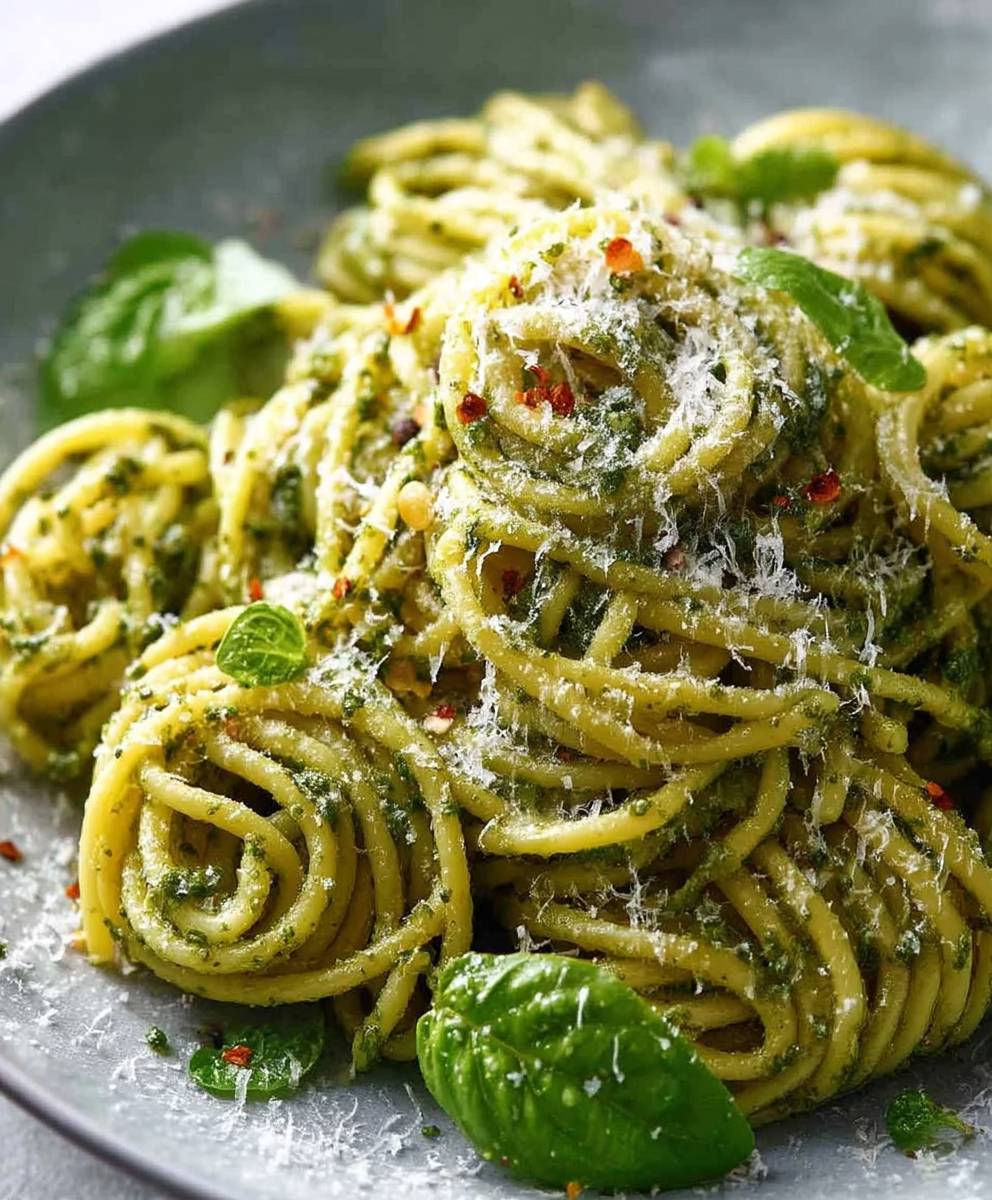Homemade Pesto: the vibrant, herbaceous sauce that elevates everything from pasta to sandwiches. Have you ever tasted pesto so fresh, so bursting with flavor, that it transported you straight to the sun-drenched hills of Liguria? That’s the magic of making it yourself, and trust me, it’s easier than you think!
Pesto, derived from the Genoese word “pestâ” meaning “to pound” or “to crush,” has a rich history rooted in the Liguria region of Italy. Traditionally, it was made using a mortar and pestle, a method that gently releases the essential oils of the basil, creating a truly unique and aromatic experience. While modern food processors offer a quicker alternative, the essence remains the same: fresh, high-quality ingredients transformed into a culinary masterpiece.
People adore homemade pesto for its unparalleled freshness and versatility. The bright, peppery bite of basil, the salty tang of Parmesan cheese, the nutty crunch of pine nuts, and the smooth richness of olive oil combine to create a symphony of flavors that dance on your palate. Plus, it’s incredibly convenient! Whip up a batch on Sunday, and you’ll have a delicious sauce ready to go for pasta night, a flavorful spread for sandwiches, or a vibrant topping for grilled chicken or fish throughout the week. Get ready to experience pesto like never before!
Ingredients:
- 4 cups fresh basil leaves, packed
- 1/2 cup pine nuts, toasted
- 2-4 cloves garlic, peeled
- 1/2 cup grated Parmesan cheese, plus more for serving
- 1/4 cup grated Pecorino Romano cheese
- 1/2 – 3/4 cup extra virgin olive oil
- Salt and freshly ground black pepper to taste
- Optional: 1 tablespoon lemon juice
Preparing the Pesto
- Wash and Dry the Basil: This is a crucial first step! Gently wash the basil leaves in cold water to remove any dirt or debris. Then, thoroughly dry them. I like to use a salad spinner for this, but you can also pat them dry with paper towels. Make sure they are completely dry, as excess water will dilute the pesto and affect its texture and shelf life.
- Toast the Pine Nuts: Toasting the pine nuts brings out their nutty flavor and adds a wonderful depth to the pesto. You can toast them in a dry skillet over medium heat, stirring frequently, until they are golden brown and fragrant. This usually takes about 3-5 minutes. Watch them carefully, as they can burn easily. Alternatively, you can toast them in the oven at 350°F (175°C) for 5-7 minutes, again, keeping a close eye on them. Let them cool slightly before using.
- Prepare the Garlic: Peel the garlic cloves. I usually start with 2 cloves and then taste the pesto later to see if it needs more. The amount of garlic you use depends on your personal preference. If you want a milder pesto, use less garlic. If you like a strong garlic flavor, use more.
- Combine Initial Ingredients in a Food Processor: Place the toasted pine nuts, garlic cloves, and about 1 cup of the basil leaves into the bowl of a food processor. Pulse a few times to coarsely chop the ingredients. This helps to break everything down before adding the remaining basil.
- Add Remaining Basil and Cheeses: Add the remaining basil leaves, Parmesan cheese, and Pecorino Romano cheese to the food processor. Pulse again until the mixture is finely chopped and well combined. You may need to scrape down the sides of the bowl a few times to ensure everything is evenly processed.
- Slowly Drizzle in the Olive Oil: With the food processor running on low speed, slowly drizzle in the extra virgin olive oil. Continue processing until the pesto reaches your desired consistency. I prefer a slightly chunky pesto, but you can process it until it’s completely smooth if you prefer. The amount of olive oil you use will depend on the texture you want. Start with 1/2 cup and add more as needed until you achieve the desired consistency.
- Season with Salt and Pepper: Season the pesto with salt and freshly ground black pepper to taste. Be careful not to over-salt, as the Parmesan and Pecorino Romano cheeses are already quite salty. Start with a small amount of salt and pepper and then taste and adjust as needed.
- Add Lemon Juice (Optional): If you like, you can add a tablespoon of lemon juice to the pesto. The lemon juice adds a bright, fresh flavor that complements the basil and cheese. I find it helps to balance the richness of the pesto.
- Taste and Adjust: This is the most important step! Taste the pesto and adjust the seasonings as needed. You may want to add more salt, pepper, garlic, cheese, or lemon juice, depending on your personal preference.
Storing the Pesto
- Transfer to an Airtight Container: Transfer the pesto to an airtight container. A glass jar works well.
- Top with Olive Oil: Pour a thin layer of olive oil over the top of the pesto. This helps to prevent the pesto from oxidizing and turning brown. It also helps to preserve the flavor.
- Refrigerate: Store the pesto in the refrigerator for up to a week. The pesto may darken slightly over time, but this is normal and doesn’t affect the flavor.
- Freeze for Longer Storage: For longer storage, you can freeze the pesto. I like to freeze it in ice cube trays. Once the pesto is frozen, transfer the cubes to a freezer bag or container. This makes it easy to thaw out small portions of pesto as needed. Frozen pesto will keep for up to 3 months.
Serving Suggestions
- Pasta: Pesto is a classic sauce for pasta. Toss it with your favorite pasta shape, such as spaghetti, linguine, or penne. Add some grilled chicken or shrimp for a complete meal.
- Sandwiches and Wraps: Spread pesto on sandwiches and wraps for a flavorful twist. It pairs well with grilled vegetables, roasted chicken, or turkey.
- Pizza: Use pesto as a base for pizza instead of tomato sauce. Top with your favorite toppings, such as mozzarella cheese, tomatoes, and olives.
- Grilled Meats and Vegetables: Brush pesto on grilled meats and vegetables for added flavor. It’s especially delicious on grilled chicken, fish, and zucchini.
- Dips and Spreads: Mix pesto with cream cheese or sour cream for a delicious dip or spread. Serve with crackers, vegetables, or bread.
- Soups: Swirl a spoonful of pesto into soups for added flavor and richness. It’s especially good in tomato soup or vegetable soup.
- Eggs: Add a dollop of pesto to scrambled eggs or omelets for a flavorful breakfast.
- Potatoes: Toss roasted potatoes with pesto for a delicious side dish.
- Salads: Use pesto as a dressing for salads. It pairs well with tomatoes, mozzarella cheese, and basil.
Tips and Tricks for the Best Pesto
- Use Fresh, High-Quality Ingredients: The quality of your ingredients will directly impact the flavor of your pesto. Use fresh basil leaves, good quality Parmesan and Pecorino Romano cheeses, and extra virgin olive oil.
- Don’t Over-Process the Pesto: Over-processing the pesto can make it bitter. Pulse the ingredients in the food processor until they are finely chopped and well combined, but avoid processing it for too long.
- Adjust the Consistency to Your Liking: The amount of olive oil you use will determine the consistency of the pesto. Add more olive oil for a smoother pesto and less olive oil for a chunkier pesto.
- Toast the Pine Nuts: Toasting the pine nuts brings out their nutty flavor and adds a wonderful depth to the pesto.
- Use a Combination of Parmesan and Pecorino Romano Cheeses: The combination of Parmesan and Pecorino Romano cheeses adds a complex and flavorful taste to the pesto.
- Add Lemon Juice for Brightness: A tablespoon of lemon juice adds a bright, fresh flavor that complements the basil and cheese.
- Store Pesto Properly: Store pesto in an airtight container in the refrigerator for up to a week or freeze it for longer storage.
- Experiment with Different Ingredients: Don’t be afraid to experiment with different ingredients to create your own unique pesto recipe. You can try using different types of nuts, cheeses, or herbs.
- Make a Big Batch: Pesto is easy to make and freezes well, so make a big batch and store it for later use.
- Enjoy! Pesto is a versatile and delicious sauce that can be used in a variety of dishes. Enjoy it on pasta, sandwiches, pizza, grilled meats, vegetables, and more!
Troubleshooting Your Pesto
- Pesto is Too Bitter: If your pesto is too bitter, it could be due to over-processing the basil or using old basil leaves. Try using fresh basil leaves and avoid over-processing the pesto. You can also add a little bit of sugar or honey to balance the bitterness.
- Pesto is Too Thick: If your pesto is too thick, add more olive oil until it reaches your desired consistency.
- Pesto is Too Thin: If your pesto is too thin, add more Parmesan cheese or pine nuts until it reaches your desired consistency.
- Pesto is Too Salty: If your pesto is too salty, add a little bit of lemon juice or water to dilute the saltiness.
- Pesto is Too Bland: If your pesto is too bland, add more garlic, Parmesan cheese, or salt and pepper to taste.
- Pesto Turns Brown: Pesto can turn brown due to oxidation. To prevent this, pour a thin layer of olive oil over the top of the pesto before storing it in the refrigerator. You can also add a tablespoon of lemon juice to help prevent browning.
Variations on Homemade Pesto
- Sun-Dried Tomato Pesto: Add 1/2 cup of sun-dried tomatoes (oil-packed, drained) to the food processor along with the

Conclusion:
This isn’t just another soup recipe; it’s a hug in a bowl, a nutritional powerhouse, and a flavor explosion all rolled into one! I truly believe this Lentil Soup recipe is a must-try for anyone looking for a comforting, healthy, and incredibly satisfying meal. From its ease of preparation to its deeply savory flavor profile, it’s a winner on all fronts. The earthy lentils, the vibrant vegetables, and the aromatic spices create a symphony of tastes that will leave you feeling nourished and content.
But what truly sets this recipe apart is its versatility. It’s fantastic as a hearty lunch, a light dinner, or even a make-ahead meal for busy weeknights. And the best part? It only gets better with time! The flavors meld together beautifully as it sits, making it perfect for meal prepping.
Serving Suggestions and Variations:
Don’t be afraid to get creative! While this recipe is delicious as is, there are countless ways to customize it to your liking.
* For a Creamier Soup: Stir in a dollop of Greek yogurt or coconut milk just before serving. This adds a lovely richness and tanginess.
* Spice it Up: Add a pinch of red pepper flakes or a dash of hot sauce for an extra kick.
* Add Some Protein: Grilled chicken, sausage, or tofu would be fantastic additions.
* Make it Vegan: Ensure you’re using vegetable broth and omit any dairy products. It’s naturally vegan-friendly as written!
* Serve with a Side: A crusty loaf of bread, a grilled cheese sandwich, or a simple green salad are all excellent accompaniments.
* Garnish with Flair: A sprinkle of fresh herbs like parsley or cilantro, a squeeze of lemon juice, or a drizzle of olive oil can elevate the presentation and flavor.
* Blend it Smooth: For a smoother, creamier texture, use an immersion blender to partially or fully blend the soup.I often enjoy mine with a swirl of pesto and a sprinkle of Parmesan cheese (if I’m not keeping it vegan). Sometimes, I’ll add a handful of spinach or kale towards the end of cooking for an extra boost of nutrients. The possibilities are endless!
I’ve poured my heart into perfecting this Lentil Soup recipe, and I’m confident that you’ll love it as much as I do. It’s a staple in my kitchen, and I hope it becomes one in yours too. It’s a fantastic way to incorporate more plant-based protein and fiber into your diet, and it’s incredibly budget-friendly.
So, what are you waiting for? Gather your ingredients, put on your apron, and get cooking! I promise you won’t be disappointed. This recipe is more than just a set of instructions; it’s an invitation to create something delicious and nourishing for yourself and your loved ones.
I’m so excited for you to try this recipe! Once you do, please come back and share your experience in the comments below. Let me know what variations you tried, what you served it with, and how much you enjoyed it. I can’t wait to hear your feedback and see your culinary creations! Happy cooking!
Homemade Pesto: The Ultimate Guide to Fresh, Flavorful Pesto
Fresh, vibrant homemade pesto bursting with basil, toasted pine nuts, garlic, Parmesan, and Pecorino Romano cheeses. Perfect for pasta, sandwiches, and more!
Ingredients
- 4 cups fresh basil leaves, packed
- 1/2 cup pine nuts, toasted
- 2-4 cloves garlic, peeled
- 1/2 cup grated Parmesan cheese, plus more for serving
- 1/4 cup grated Pecorino Romano cheese
- 1/2 – 3/4 cup extra virgin olive oil
- Salt and freshly ground black pepper to taste
- Optional: 1 tablespoon lemon juice
Instructions
- Wash and Dry the Basil: Gently wash basil leaves in cold water and thoroughly dry them.
- Toast the Pine Nuts: Toast pine nuts in a dry skillet over medium heat (3-5 minutes) or in the oven at 350°F (175°C) for 5-7 minutes until golden brown. Let cool.
- Prepare the Garlic: Peel garlic cloves (2-4, depending on preference).
- Combine Initial Ingredients: Place toasted pine nuts, garlic, and 1 cup of basil leaves in a food processor. Pulse to coarsely chop.
- Add Remaining Basil and Cheeses: Add remaining basil, Parmesan, and Pecorino Romano to the food processor. Pulse until finely chopped and well combined, scraping down sides as needed.
- Slowly Drizzle in Olive Oil: With the food processor running on low, slowly drizzle in olive oil until desired consistency is reached (start with 1/2 cup and add more as needed).
- Season with Salt and Pepper: Season with salt and pepper to taste.
- Add Lemon Juice (Optional): Add lemon juice for brightness.
- Taste and Adjust: Taste and adjust seasonings as needed.
Notes
- Use fresh, high-quality ingredients for the best flavor.
- Don’t over-process the pesto, as it can become bitter.
- Adjust the consistency by adding more or less olive oil.
- To prevent browning, top stored pesto with a thin layer of olive oil.
- Pesto can be stored in the refrigerator for up to a week or frozen for up to 3 months.





Leave a Comment